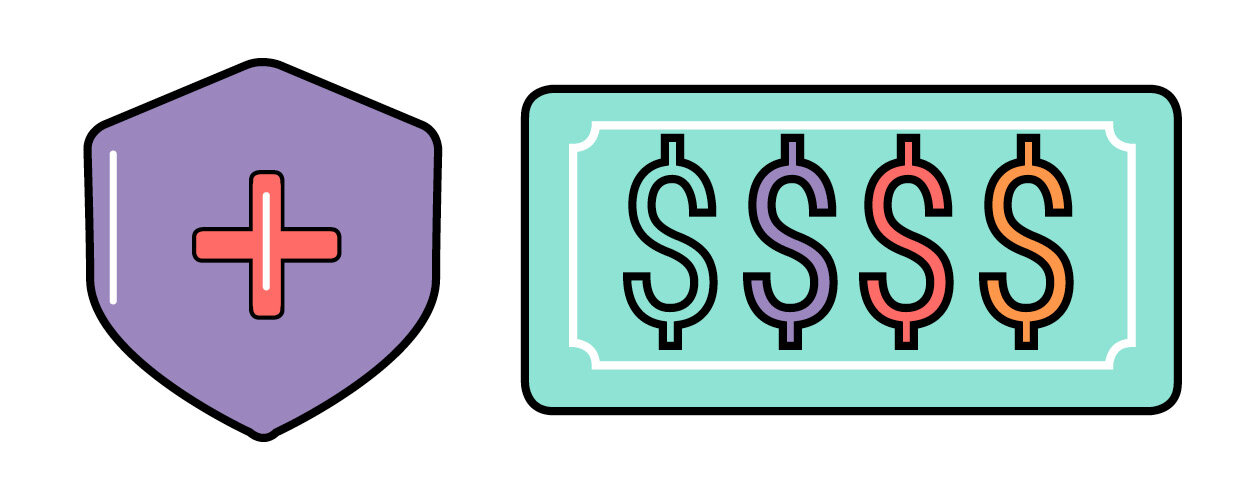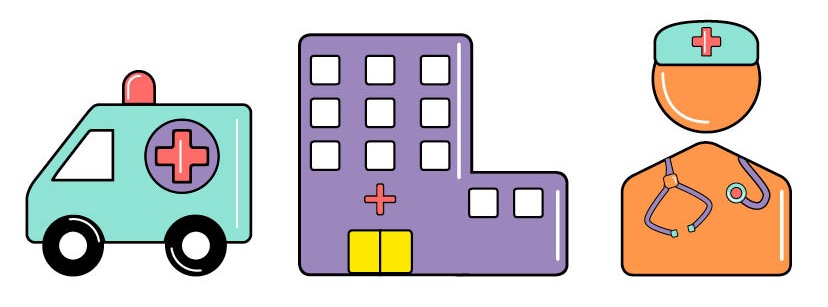The Emergency Room (aka ER, Emergency Department, or ED): one of the most expensive and confusing places in healthcare. Savvy Healthcare Hustlers don’t go in to any healthcare situations blind, so we’ve called in a professional to show you the ropes, offering tips and advice on how best to manage a trip to the Emergency Room. Remember that ERs can be expensive, and you want to check your EOBs for balance billing.
Claire Phillips is an Emergency Department Registered Nurse and writer/creator of the blog: Nursing the System. As a full-time nurse she explains the process for visiting the ER and how to make your trip as easy as possible for you (and the staff)!
Claire take it away…
Thanks Bryanna and Kirsten, let me first start by setting the stage:
Your day is not going well you have chest pain, you took some medication at home with no relief, you called your primary care provider, and ruled out Urgent Care. This is a medical emergency and you’re headed to the ER.
Your knowledge of an Emergency Room may come from Grey's Anatomy and while you don’t do this every day, I do. I’m Claire Phillips, an Emergency Department Registered Nurse.
Before you’re in pain, panicked, or in crisis - before you’re my patient - I offer you a road map for your next visit to the Emergency Department (ED, technically what many ERs are now called). On one of the worst days of your life, perhaps I can help you put some anxiety aside.
When you walk into any Emergency Department, you are entering the care of highly specialized, competent professionals, and while no one can predict your outcome or treatment plan, I can prepare you for the general direction your care will take.
Arriving at the Emergency Department
There are two ways to arrive to the ED. You can either come in through:
The waiting room
By ambulance
Most people come through the waiting room, so let’s focus our attention there.
First, you will register as a patient at the front desk by showing your ID and insurance information (make sure to have those with you!). The staff will update your medical record and ask you about for your “chief complaint” i.e: "I’m having chest pain”.
The next step is Triage, aka the process hospitals use to determine the priority of the patient’s treatment based on severity of medical needs..
The Triage Process
The ED staff must determine the acuity of your condition, i.e. If you are at risk of death, you want to be treated immediately!
A triage nurse will call your name from the lobby, and have you enter into a private room where they will likely ask you an open-ended question like, “tell me what brings you in today."
This is where it’s important to give a brief summary of your symptoms and relevant medical history. i.e.“I’ve been having chest pain on the left side for about 30 minutes. I thought it would go away, but it’s is getting worse. I’ve never had anything like this happen before, but I’m nervous because my brother had a heart attack last year. That’s how I knew to chew up four baby aspirin on the way here.”
The RN will take your vital signs which include, blood pressure, oxygen saturation, temperature, breathing rate, and pulse. Sometimes they’ll measure your height and weight, or check your heart rhythm, with an EKG (electrocardiogram, a device that measures the electrical heart activity). The nurse may also ask you some screening questions about mental health, infectious disease, and your current living situation.
This is a quick (about 5-10 minutes), non-invasive, info gathering session., All equipment goes on over your clothes, and doesn’t involve anything scary (like needles!).
Know that the Emergency Department is not first come, first serve. The sickest patients needing the most immediate attention will be seen first. If you arrive with serious symptoms like that of a heart attack, sepsis, or stroke, you may be roomed immediately.
If you’re walking and talking, and your vital signs look okay, you will spend some more time (sometimes a long time) in the waiting room. This can be frustrating, especially if you’re anxious and in pain. But having to wait is actually a good sign because it means you’re not critically ill! Be assured that if one day, you come in with a life-threatening condition, you will be the first one through those double doors!
The Treatment Process
Once your name is called and you are in a treatment room, you’ll be asked to change into a gown. You may be hooked up to more cuffs and wires. A nurse will come in and ask you about your story, do a physical assessment, and make some notes.
After some time, a provider - either a physician, physician’s assistant, or nurse practitioner - will come in to do another interview and physical assessment. The nurse and provider will then order diagnostic tests and treatments.
Common diagnostic tests in the ED are x-rays, CT scans, blood, and urine labs, and EKGs. Common treatments include IVs, medications, fluids, catheters, and breathing treatments. Your room is home base. You may be taken to other parts of the hospital to have your procedures and imaging completed, but in most cases, you will return to that original room to await results.
Throughout your time in the ED, think of me, your nurse, as your care manager. It is my responsibility to assess and monitor your status, administer treatments, and evaluate their effectiveness. I will probably be the person you see most during your stay. I’ll be in your room at least once an hour, checking your blood pressure, listening to your lungs, and titrating (measuring and adjusting) your medication drip. If you have any questions or needs, you can direct them to me.
Unfortunately, I will make unpleasant requests of you - such is the nature of being a patient. I will ask you to wear an ugly, backless gown and likely poke you with a needle. I might have you drink gross medicine, and maybe even ask you to pee in a cup. I’ll tell you you cannot eat until your test results come back, and I’ll limit the number of visitors you have in your room.
Every now and then, you may protest a request. That is absolutely your right, but know this:
You have come to the Emergency Department for our help. There is not one thing an ED nurse will ask of you that is not absolutely necessary. Your nurses hustle 12 hours a day, strategically planning each next minute. Every step we take, every ask we make is part of a coordinated routine we’ve developed to give our patients the best, most timely care. Your cooperation gets you the care you need as smoothly as possible.
The focus of emergency medicine is to identify and treat time-sensitive, life-threatening conditions - or rule them out. Is your chest pain from a heart attack or is it acid reflux? Your lab and imaging results, along with your response to various treatments, inform your provider’s decisions. For many patients, this discernment process is not a straight line. It can take a significant amount of time.
The average length of stay in a Emergency Department in the US is greater than 4 hours. If you have a condition that requires admission to the hospital, your ED length of stay can be closer to 6 hours and unfortunately long stretches of time may go by without a status update. You may sit in your room, anxious and uncomfortable. Your nurse may not have been in to check on you for 45 minutes. It seems like no one is paying close attention.
I am on the receiving end of these complaints all day, every shift. Let me put your mind at ease, we ABSOLUTELY care. A large portion of your care in the ED goes on outside of your room, while you may not see us when we're outside your room, I can assure you we are hard at work on your case!
While you’re watching bad daytime television, the lab is hard at work running your blood samples through a series of tests. A radiologist somewhere is interpreting your CT scan and calling your provider with concerning results. I, your nurse, am with the pharmacist, clarifying the dosage of medication I’m about to give you.
We will do our very best to manage your pain while you’re with us. However, we cannot guarantee you a pain-free experience. Some conditions just hurt, even if you’re getting the strongest medications. Your time in the ED may not be comfortable, but it will be safe.
Leaving the Emergency Department
If your condition requires further monitoring, significant treatment, or surgery, you will be admitted to the hospital. If it does not, you will be discharged home.
The Emergency Department will not always find the cause of your symptoms. That means you may go home without an answer and a referral to see another provider. What we can tell you is that to the very best of our knowledge, you are not having a medical emergency.
No one enjoys going to the hospital, and people’s responses to stressful, painful situations vary. Some patients become frustrated and demanding, lash out at staff, and try to control a process that is much bigger than them. As your nurse, I take the brunt of this negative energy. I ask you: If you are confused about a process or a decision that has been made, please take a breath. Ask us questions, we are happy to have a conversation.
Please trust your team. We do this all day, every day. If we didn’t care, we wouldn’t be in this profession. We will always do our best to keep you safe, to make you comfortable, and most importantly, to save your life.
Meet Claire!
Claire is an Emergency Department nurse with a love for system analysis. She is a Doctor of Nursing Practice candidate, completing a degree in Health Innovation and Leadership. Claire is passionate about connecting nurses to the information they need to navigate the chaos of our healthcare system - and be powerful forces for change.
Follow her writing on Facebook, Twitter, Instagram, and her website, www.nursingthesystem.com.
Facebook: @nursing.the.system
Twitter: @nursethesystem
Instagram: @nursing.the.system





